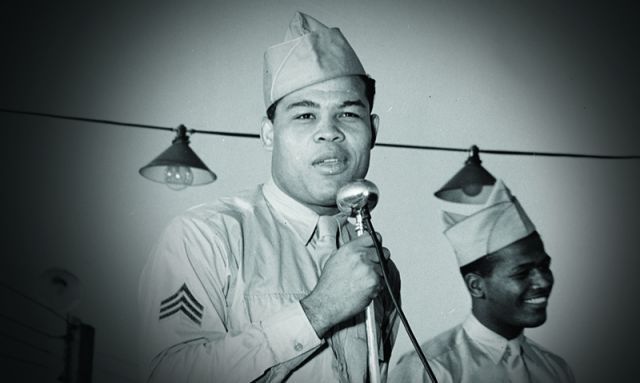
The Brown Bomber
More than 16 million men and women raised their right hands and swore an oath of enlistment into the U.S. military during World War II. Only one was the world heavyweight boxing champion: Joe Louis. Like many Americans, he was drafted into the Army, enlisting under his legal name, Joe Louis Barrow, on Jan. 14, 1942. A champion fighter in the boxing ring, he was ready to fight for the United States.
Born in Alabama in 1914, Louis was one of eight children born to Munroe and Lillie Barrow. His mother later married a widower, who added his six children to the household. When he was about 12, his family moved to Detroit, where work opportunities were better for African Americans. Louis had been slow to develop, walking and talking later than many children. He did not excel in school and by 15 quit, working instead to support his family.
In his late teenage years, Louis began boxing with a friend and found he had a particular talent for the sport. By 1934, he had won 50 of 54 amateur fights and had his sights set on going pro. Louis fought his first professional match on July 4, 1934, and won with a knockout in the first round. Louis’ success quickly made him a hero to Black Americans. Unlike his predecessor, heavyweight champion Jack Johnson, Louis was naturally reserved, a trait his managers urged him not to lose. His quiet demeanor served him well. When he spoke, people listened.
Louis spoke loudest with his fists. In 1937, he defeated heavyweight champion James J. Braddock, earning the title for himself. The next year, Louis faced German boxer Max Schmeling in a rematch that carried the weight of two ideologies: a Black American boxer squaring off with Nazi Germany’s prized fighter. Their first match, in 1936, was a loss for Louis. This time, he knocked Schmeling out in the first round. With this victory, Louis’ popularity grew with Black and white Americans. When he donned an Army uniform in 1942, he still held the heavyweight title.
Prior to Louis’ enlistment, the Army’s Bureau of Public Relations was discussing what to do with the famous boxer. Although numerous celebrities joined the military during World War II and were given (or allowed to have) combat assignments, Louis’ opportunities in a segregated Army were few. It was determined he would serve Uncle Sam doing what he did best: boxing. Louis attended boot camp; he had to learn how to be a soldier even if he would not fight. In March 1942, he was allowed to defend his title; he beat Abe Simon and raised money for the Army Emergency Relief Fund.
A poster of Louis, dressed in combat gear and wielding a rifle with a fixed bayonet, became a wildly popular war-bond advertisement. Quoting a speech Louis gave at a fundraiser, the poster exclaimed, “We’re going to do our part ... and we’ll win because we’re on God’s side.” Louis did his part, assigned to a traveling group of Black boxers and entertainers. The troupe was an enormous success, drawing huge crowds of GIs across the United States and eventually throughout Europe.
Louis did a lot to lift the morale of GIs. Getting to see your hero box in person was something thousands of young men must have written home about. One story recounted a young GI willing to risk his already damaged eyesight just for a glimpse of America’s “Brown Bomber.” If Louis had any problems with his ambassador role, he never told anyone. There was just one known rule: he refused to box in front of segregated audiences. The military was willing to bend its rules for few, but it did for Louis.
In addition to supporting millions of GIs through his appearances and shows, Louis stepped in to help friends when needed. When officer candidate (and future baseball star) Jackie Robinson knocked out a white officer’s teeth over racist remarks, Louis made some phone calls. He not only managed to keep Robinson from being court-martialed or worse, but he carried enough clout out of the ring to help keep him in officer candidate school. Traveling across the country, Louis could gather information and use his status to make changes, and he is credited with helping to desegregate Army buses.
Like the millions with whom he served, Louis had to adjust to life outside the Army after the war. He joined The American Legion as a member of Peter Salem Post 45 in Louisville, Ky. He continued to box, though years of exhibitions had taken a toll on him. He defended his heavyweight title until his retirement in 1949, when it had become apparent he was no longer in peak form. In 1950, Louis came out of retirement, necessitated by debts and trouble with the IRS. His last match was Oct. 26, 1951, against fellow Army veteran and then-heavyweight contender Rocky Marciano. Marciano won and apologized to Louis; even his opponent hated to see the heavyweight great fall short.
Upon Louis’ death, President Ronald Reagan waived the stringent requirements for internment at Arlington National Cemetery, and America’s hero was buried there with full military honors April 21, 1981.
Despite winning millions over his career, it is estimated Louis personally earned less than $1 million. He never shook his troubles with the IRS, though he was able to live comfortably. Louis pursued other passions, especially golf. Among the many strides he made for civil rights, directly or indirectly, it was his desire to play in the 1952 San Diego Open that resulted in the removal of the bylaw excluding Black golfers from the Professional Golfers’ Association of America (today’s PGA Tour). Whether it was in the boxing ring, on the fairways or in an Army uniform, Louis set himself apart as a fighter, advocate, friend and veteran.
Kali Martin Schick is senior historian at the National Medal of Honor Museum.
